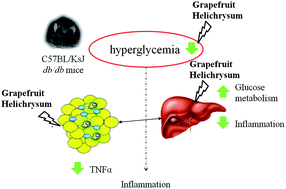Modulation of hyperglycemia and TNFα-mediated inflammation by helichrysum and grapefruit extracts in diabetic db/db mice
Abstract
Type-2 diabetes is associated with a chronic low-grade systemic inflammation accompanied by an increased production of adipokines/cytokines by obese adipose tissue. The search for new antidiabetic drugs with different mechanisms of action, such as insulin sensitizers, insulin secretagogues and α-glucosidase inhibitors, has directed the focus on the potential use of flavonoids in the management of type-2 diabetes. Thirty six diabetic male C57BL/6J db/db mice were fed a standard diet and randomly assigned into four experimental groups: non-treated control, (n = 8); acarbose (5 mg per kg bw, n = 8); helichrysum (1 g per kg bw, n = 10) and grapefruit (0.5 g per kg bw, n = 10) for 6 weeks. The mRNA expression in pancreas, liver and epididymal adipose tissue was determined by RT-PCR. DNA methylation was quantified in epididymal fat using pyrosequencing. Mice supplemented with helichrysum and grapefruit extracts showed a significant decrease in fasting glucose levels (p < 0.05). A possible mechanism of action could be the up-regulation of liver glucokinase (p < 0.05). The antihyperglycemic effect of both extracts was accompanied by decreased mRNA expression of some proinflammatory genes (monocyte chemotactic protein-1, tumor necrosis factor-α, cyclooxygenase-2, nuclear factor-kappaB) in the liver and epididymal adipose tissue. The CpG3 site of TNFα, located 5 bp downstream of the transcription start site, showed increased DNA methylation in the grapefruit group compared with the non-treated group (p < 0.01). In conclusion, helichrysum and grapefruit extracts improved hyperglycemia through the regulation of glucose metabolism in the liver and reduction of the expression of proinflammatory genes in the liver and visceral fat. The hypermethylation of TNFα in adipose tissue may contribute to reduce the inflammation associated with diabetes and obesity.


 Please wait while we load your content...
Please wait while we load your content...